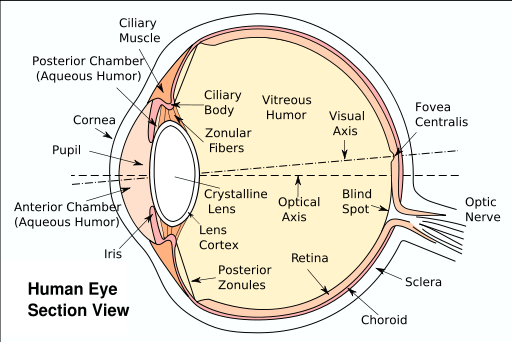Cataract vs Glaucoma
Glaucoma and cataract are two common eye disorders. Simply because these are so common and are related to common diseases like diabetes, it is important to understand the differences between the two. This article describes the clinical features, symptoms, causes, diagnosis, and treatment methods of glaucoma and cataract and explains the difference between glaucoma and cataract.
Before looking into the diseases, it is useful to get an idea of the anatomy of the eye. The eye is a complex sensory organ. It is covered with a strong fibrous outer layer called the sclera. The sclera is transparent in the front of the eye to make the cornea. Behind the cornea, there is the anterior chamber filled with aqueous humor. The anterior chamber is limited posteriorly by the ciliary body, pupil and iris. Behind the pupil, the lens is attached to the ciliary body by fibrous bands. Behind the lens, the posterior chamber is filled with vitreous humor. Posterior aspect of the posterior chamber is lined by the retina and a layer of blood vessels supplying the retina.
Glaucoma
Glaucoma is excessive pressure of aqueous humor in the anterior compartment of the eye. Aqueous humor is secreted by the epithelium of the ciliary body and the pupil. It travels across the anterior chamber and goes out through the angle between the cornea and the ciliary body. There are three basic mechanisms that increase the pressure of aqueous humor; increased secretion, poor drainage, and mass effects. The epithelium secretes aqueous humor excessively when it is inflamed. The angle and the canal of Shclemn may get obstructed, and choroid may absorb aqueous humor slower than normal. The angle may be open or closed; thus there are two types of glaucoma; open and closed angle glaucoma. Glaucoma due to excessive secretion falls into the open angle variety. Obstruction of the angle reduces drainage, and it is a closed angle type of glaucoma.
Glaucoma may present acutely or chronically. Acute closed angle glaucoma is an emergency and needs immediate treatment. In acute glaucoma, patients present with painful, red eye with blurred vision. There may be an associated headache on the same side. The eyeball is tender to touch, and the pupil is dilated, fixed, the cornea is hazy, and slit lamp examination is diagnostic. Chronic glaucoma is a silent killer of vision. Because there is no pain, the patient usually presents when the vision starts to deteriorate.
Treatment of glaucoma is complex. Because the eye sight is essential for balance and postural control, all steps should be taken to preserve other sensations to ensure balance control. Prostaglandin analogues increase aqueous flow through the angle. Beta blockers and carbonic anhydrase inhibitors reduce aqueous secretion. Glaucoma surgeries include canaloplasty, laser surgery, drainage implants, deep sclerotomy and trabeculectomy.
Cataract
In cataract, the lens gets opaque. It is the commonest cause of age related loss of vision. It may also occur in the newborn due to conditions like congenital rubella syndrome. Cataract is due to degeneration and denaturation of lens proteins with ageing, blunt trauma, radiation, drugs (steroids, miotics), and metabolic disorders. Patients present with slow blurring of vision. Diabetes increases the risk and hastens the age of onset. Treating causative conditions may slow the progression of cataract. In most cases, the lens needs to be replaced to regain full vision.
What is the difference between Glaucoma and Cataract?
• Glaucoma is the increased aqueous pressure and cataract is the lens becoming opaque.
• Glaucoma is common in middle aged individuals while cataract is common in the elderly.
• Acute glaucoma causes painful red eye while cataract does not.
• Loss of vision by glaucoma may not be regained while, in cataract, vision returns with lens replacement.
• Glaucoma may be managed medically while surgery is the definitive cure for cataract.
ncG1vNJzZmivp6x7pbXFn5yrnZ6YsqOx07CcnqZemLyue8OinZ%2Bdopq7pLGMm5ytr5Wau26vwK2Yq5mTqXqiusNmnqWZpZi8rq2O
